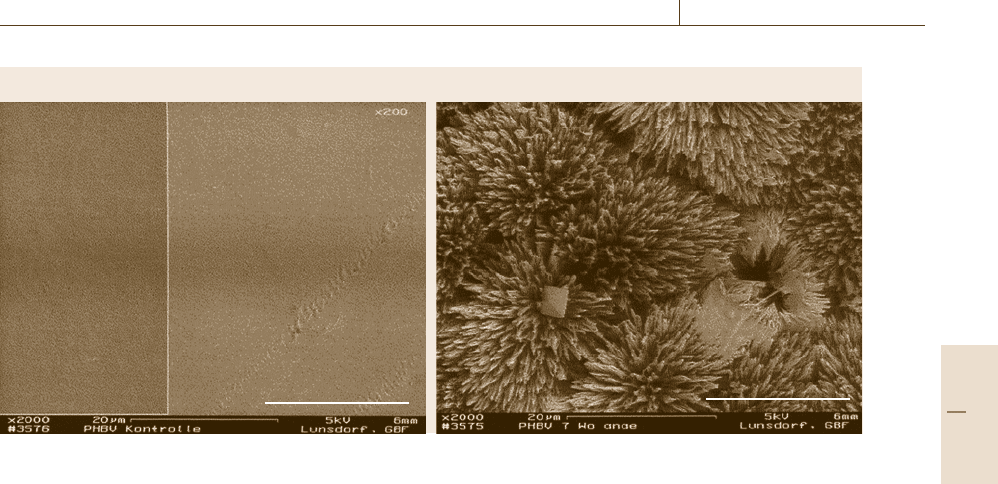Czichos H., Saito T., Smith L.E. (Eds.) Handbook of Metrology and Testing
Подождите немного. Документ загружается.


788 Part D Materials Performance Testing
which has been treated some time previously with
wood preservative applied by dip, brush or spray and
on which eggs of Anobium punctatum are laid.
•
European Standard EN 49-2: Determination of the
protective effectiveness against Anobium punctatum
(De Geer) by egg-laying and larval survival – Part 2:
Application by impregnation (laboratory method).
In contrast to part 1 of this standard, this method
simulates conditions which can occur in practice
on timber which has been treated some time pre-
viously with a deeply penetrating wood preserva-
tive and on which eggs of Anobium punctatum are
laid.
Specific Tests for Resistance Against Wood-Boring
Beetles (Curative Control Measures). When susceptible
wood is infested with beetle larvae at low density, the
infestation can be cured before structural damage oc-
curs. This work requires to be done by experts only. The
wood preservative is usually applied by surface applica-
tion through brushing or spraying and has to penetrate
deep enough for contact with tunnelling larvae.
•
European Standard EN 1390: Determination of the
eradicant action against Hylotrupes bajulus (Lin-
naeus) larvae (laboratory method). This standard
describes a laboratory test method which gives a ba-
sis for assessment of the eradicant action of a wood
preservative against Hylotrupes bajulus. It allows
determination of the lethal effect of a surface appli-
cation of a preservative product on a population of
large larvae previously introduced into the test spec-
imens. The method simulates conditions in practice
where a stake is treated which is only slightly at-
tacked and where insect tunnels have been exposed
by cutting away. This represents a valid test of the
product.
•
European Standard EN 48: Determination of the
eradicant action against larvae of Anobium puncta-
tum (De Geer) (laboratory method). This standard
describes a laboratory test method which gives a ba-
sis for assessment of the eradicant action of a wood
preservative against Anobium punctatum. It allows
the determination of the lethal effect of a surface
application of the preservative on a population of lar-
vae already established in the test specimens. The
method simulates conditions which can occur in
practice where a length of wood such as an affected
stair tread is treated, which is still free from exit holes
and in which certain of the faces are inaccessible,
thus constituting valid test conditions.
•
European Standard EN 370: Determination of erad-
icant efficacy in preventing emergence of Anobium
punctatum (De Geer). This standard describes a lab-
oratory test method which gives the basis for the as-
sessment of the eradicant efficacy of a wood preser-
vative in preventing emergence of Anobium punc-
tatum. It determines the lethal effects, on beetles
attempting to emerge through treated wood sur-
faces, of an insecticidal product deposited by surface
application.
Specific Test for Resistance Against Termites. Termite
control is not achievable by curative treatment of in-
fested wood. Usually, the damage caused by termites
is already too severe by the time termite-infested wood
is detected. Wood preservative action against termites
focuses on preventive treatment of the endangered ma-
terial or the creation of biocidal or physical soil barriers.
The test species may varydepending on the geographical
situation.
•
European Standard EN 117: Determination of toxic
values against European Reticulitermes species (lab-
oratory method). This standard describes a labora-
tory test method which gives a basis for assessment
of the effectiveness of a wood preservative against
Reticulitermes species. It allowsthe determination of
the concentration at which the product completely
prevents the attack by this insect of impregnated
wood of a susceptible species.
•
European Standard EN 118: Determination of pre-
ventive action against European Reticulitermes
species (laboratory method). This standard describes
a laboratory test method which gives a basis for as-
sessment of the effectiveness of a wood preservative,
when applied as a surface treatment, against Retic-
ulitermes species.
•
American Society for Testing and Materials
ASTM D 3345: Laboratory evaluation of wood and
other cellulosic materials for resistance to termites.
This method covers the laboratory evaluation of
treated or untreated cellulosic material for its resis-
tance to subterranean termites. This test should be
considered as a screening test, for treated material
and further evaluation by field methods is required.
•
American Wood-Preservers’ Association Standard
E1-72: Standard method for laboratory evaluation to
determine resistance to subterranean termites. This
method provides for the laboratory evaluation of
treated or untreated cellulosic material for its resis-
tance to subterranean termites. This test should be
Part D 14.2

Biogenic Impact on Materials 14.3 Testing of Organic Materials 789
considered as a screening test for treated material and
further evaluation by field methods is required.
•
Australian Standard 2178: Protection of buildings
from subterranean termites – detection and treatment
of infestation in existing buildings. This standard
sets out methods for the detection and treatment of
subterranean termite infestation in existing buildings
and also sets out methods for the prevention of rein-
festation.
•
Japan Wood Preserving Association Standard 11(2):
Method for testing the effectiveness of surface treat-
ments of timber (brushing, spraying and dipping)
with termiticides against termites (2) field test. This
standard describes a field test method for evaluat-
ing effectiveness of surface treatments of timber such
as brushing, spraying and dipping with termiticides
against termites.
•
Japan Wood Preserving Association Standard 12:
Method for testing the effectiveness of pressure
treatment of timber with termiticides against ter-
mites. This standard describes laboratory and field
test methods for evaluating effectiveness of pressure
treatment of timber with terniticides against termites.
•
Japan Wood Preserving Association Standard 13:
Method for testing the effectiveness of soil treatment
with termiticides against termites. This standard de-
scribes a test method for evaluating effectiveness of
soil treatment with termiticides against termites.
•
Japan Wood Preserving Association Standard 14:
Qualitative standards for termiticides, preservative/
termiticides and soil-poisoning termiticides. This
standard describes qualitative standards for termiti-
cides, preservative/termiticides and termiticides for
soil treatment.
14.3 Testing of Organic Materials
Polymeric materials (plastics) are used in all sectors of
life as very durable products with tailor-made proper-
ties. They provide a combination of easy thermoforming
(most plastics, if not cross-linked) and excellent use
properties. For some applications, such as paints, items
in the automobile industry or for use in buildings,
they have to maintain their properties for a long pe-
riod of time, often decades. The long-lasting exposure
to environmental factors often results in a change of
material properties such as roughening of the surface,
embrittlement, a loss in mechanical strength or just
a discoloration. It has been observed in some cases
that also the presence of microorganisms such as bac-
teria, fungi or algae can cause or enhance changes in
plastics, although most plastics are supposed to be in-
ert to attacks of microorganisms (they do not rot). All
these effects usually are not desired and are denoted
generally as biocorrosion or as biodeterioration, if the
material falls apart due to the ageing process. A num-
ber of test methods have been developed to characterize
these phenomena.
However, the increasing stability of many plastics
against environmental ageing in combination with the
intense use of modern plastics generated serious prob-
lems with plastic waste in the last decade, especially
from plastic packaging. Alternative waste management
strategies to landfilling such as incineration or plastics
recycling are not always optimal and the subject of very
controversial discussions. On this background intensive
attempts were made since the early nineties to develop
novel plastics which combine a good performance,
comparable to conventional polymers, with a controlled
susceptibility to microbial degradation. This new class
of materials is usually called biodegradable plastics.
Applications of theses materials are, e.g., bags for col-
lecting biowaste, packaging (disposed via composting),
or mulch films in agriculture.
For these novel materials which are claimed to be
environmentally friendly, it is demanded to prove their
environmentally safe biodegradation using scientifically
based and generally accepted methods. Concerning the
parameters used for monitoring biodegradation, the test-
ing procedures applied and the evaluation criteria for
biodegradability of plastics significantly differ from
testing biocorrosion phenomena of plastics. Hence, an
own system of test methods and evaluations criteria is
being developed for this kind of materials.
14.3.1 Biodeterioration
In contrast to the biodegradation of plastics, where
a near complete conversion of the material compo-
nents into naturally occurring metabolic products of
microorganisms (e.g., water, carbon dioxide, methane,
biomass etc.) occurs (see later), for biocorrosion or
biodeterioration processes only a change in the poly-
mer structure or the plastics composition is observed in
many cases [14.22].
Part D 14.3

790 Part D Materials Performance Testing
General Mechanism of Biodeterioration
Since usually mechanical properties of plastics are pre-
dominantly determined by the length of the polymer
chains in the material, scission of polymer chains (re-
duction of the average molar mass) is one major reason
for changes in mechanical properties. This effect is es-
pecially dramatic if the cleavage of the polymers occurs
statistically along the chains (endo-degradation) and not
at the ends (exo-degradation). Even just a single endo-
cleavage in a polymer chain can reduce the molar mass
to 50%, and hence cause significant changes in mech-
anical properties.
Embrittlement (=loss in elasticity), however, can
also occur when plasticizers are removed from the
plastic materials by microorganisms. Especially for
polyvinylchlorides (PVC), which in some cases contain
high amounts of plasticizers (e.g., low-molecular-
weight esters), biocorrosion due to this phenomenon
has been reported in earlier times [14.23–25]. A similar
effect is observed in polymer blends or (block)-
copolymers when single components are selectively
degraded by microorganisms. An example for this
mechanisms of biodeterioration are mixtures of (un-
modified) polyethylene and starch. Here the starch
basically can be metabolized by microorganisms, lead-
ing to a weakening of the entire material and finally
result in fragmentation [14.26].
If the attack of microorganisms only concerns side
groups attached to the polymer main chains, this usu-
ally results in a change of the chemical characteristic
and hence, in the material properties. The cleavage of
ester bonds in side chains of cellulose esters (e.g., cel-
lulose acetate) results in the formation of charged
chemical groups (at suitable pH values) increasing the
Exposure time
Property
Surface erosion
Mechanical strength
of test item
Mass of
test item
Exposure time
Property
Bulk degradation
Mechanical strength
of test item
Mass of test item
a)
b)
Fig. 14.7a,b Influence of surface erosion (a) andbulkdegradation
(b) on the material properties of plastics
hydrophilicity of the material (this can be followed by
an increased water uptake and swelling of the material).
If a sufficiently high amount of esters has been trans-
formed into hydroxyl groups the entire material can
become accessible to direct microbial attack [14.27,28].
Similar effects can be caused by oxidation phenom-
ena, where new polar carbonyl and carboxylgroups are
formed in the polymer (or at the surface of the polymer).
Coloring of plastics can be caused due to the for-
mation of new chromophoric chemical groups, but also
the release of pigments from microorganisms can cause
changes in the color of plastic materials.
Strictly speaking, real biodegradation involves the
direct action of enzymes (biocatalysts) on the plas-
tic material itself. The hydrolysis of ester bonds in
polyesters by hydrolases is such a case [14.29–31].
However, in biodeterioration processes microorganisms
mostly indirectly contribute to changes in the plastic
materials. During microbially induced oxidative degra-
dation of plastics (in nature, for instance present in
degradation of lignin or latex [14.32]), the oxidative en-
zymes do not directly act on the polymers, but produce
low-molecular-weight oxygen compounds which dif-
fuse into the polymer material and there cause chemical
reactions. Microorganisms can also indirectly induce
hydrolytic degradation processes by changing the pH
in a microenvironment at the surface of the material
(e.g. in biofilms, see below) or through the excretion,
e.g., of organic acids such as lactic acid or acetic acid as
products of their metabolism.
In real environments, however, corrosion phenom-
ena of plastics are often a mixture of physical, chemical
and biological processes. Chemical hydrolysis caused
by water which has been diffused into the polymer
and oxidation induced by light (photo-oxidation) or
by increased temperatures (thermal oxidation)inmany
cases play an important role during biocorrosion and
biodeterioration. In fact, the expression environmental
corrosion would be an expression, better meeting the
point than biocorrosion.
The mechanism and the impact on the plastics dif-
fer basically between chemical or physically processes
and the direct action of enzymes on the polymer. While
water and oxygen are small molecules which are in prin-
ciple able to penetrate into the entire plastic material,
enzymes are too large to diffuse into the polymer bulk,
and thus, can only act at the surface, causing a typical
erosion process, where the material is affected layer by
layer from the surface. This is illustrated in Fig. 14.7 for
the chemical (bulk degradation) and enzymatic hydrol-
ysis (surface erosion) of e.g. a polyester.
Part D 14.3

Biogenic Impact on Materials 14.3 Testing of Organic Materials 791
While for the enzymatic action only a small part of
the material at the surface knows about the degradation
which proceeds slowly from the surface, chemical hy-
drolysis caused from water contained in the plastics,
affects the entire material right from the beginning. As
a consequence, changes in mechanical properties and
mass loss due to degradation run in parallel for the en-
zymatic degradation. In contrast, chemical hydrolysis
causes chain scissions in all polymer chains simulta-
neously, resulting in an instant decrease in mechanical
strength, while a mass loss of the material is only ob-
servable at a later stage of degradation, where polymer
chains become so short to be water soluble.
Biofilms
One important phenomenon in correlation with biode-
terioration and biocorrosion is the forming of biofilms
on material surfaces, also known as biofouling [14.22].
Formation of biofilms is not only restricted to poly-
mer materials, but also plays a central role in corrosion
of, e.g., concrete, stones (buildings) and metals. Such
biofilms consist of a combination of various microor-
ganisms which is highly complex and variable in
time and includes the microorganisms themselves and
additionally a number of extracellular polymeric sub-
stances, e.g., polysaccharides. Biofilms represent an
own microenvironment at the surface of the materials
providing optimal living conditions (humidity, pH, nu-
trient concentrations) for the microorganisms inhabiting
the biofilm and protecting them from external attacks,
e.g., from other bacteria or fungi, and also to a certain
extent from biocides.
In biofilms the concentration of polymer-degrading
enzymes, but also, e.g., of oxidating agents formed by
the microorganisms can substantially be higher than in
a liquid environment, where such substances can dif-
fuse away from the surface. Also concerning the pH
value, biofilms can present totally different conditions
to the material surface than be measured in the liquid
environment. Thus, the presence of such biofilms on
polymer surfaces can substantially influence biodeteri-
oration phenomena of plastics.
Standards for Evaluation of Biodeterioration
As mentioned above biodeterioration is usually a very
complex process, involving the direct or indirect action
of diverse microorganisms forming often a biofilm on
the material surfaces and also including in many cases
nonbiotic actions such as irradiation or thermal oxi-
dation. As a consequence, the corresponding standard
procedures for testing biodeterioration and biocorrosion
phenomena of plastics are correlated to different top-
ics. On the one hand, a number of materials different
from plastics such as steel, concrete, textiles or paints
are covered, on the other hand, also nonbiotic factors
(light, heat, oxygen, moisture, chemicals) are regarded
in such tests exclusively or in combination with biotic
influences. Thus, only a limited number of tests strictly
deal with pure biocorrosion or biodeterioration mecha-
nisms of plastics. Those tests, only focussing on biotic
effects usually use a number of defined test organisms
(Table 14.3). However, in many cases simulation or field
tests are used which combine the action of biotic and
nonbiotic factors. These standards often are correlated
with the expression weathering – a selection of such
standards is also included in Table 14.3.
14.3.2 Biodegradation
At the beginning of the nineties a novel group of
polymers were developed which were intended to be
degradable by microorganisms in a controlled manner,
but at the time were no adequate methods and criteria
available to evaluate the property of biodegradability.
First tests carried out at that time (e.g., by using the
growth of microorganisms on the surface or a cer-
tain loss in mechanical properties such as the tensile
strength as indicators for biodegradation) originated
from the field of plastics biocorrosion and biodeterio-
ration (see above). However, these evaluation methods
proved to be unsuitable to characterize biodegradable
materials. A first generation of modified polyethylenes,
claimed to be biodegradable based on these tests, did
not meet the expectations of the users and caused to
some extent a general negative image of biodegradable
plastics at the time. As a consequence, the development
of suitable testing methods and evaluation criteria for
biodegradable plastics started and resulted in a num-
ber of standards of various national and international
standardization agencies during the past 15 years. This
process still continues, since the number of different en-
vironments, where plastics can be degraded, make it
necessary to establish a quite complex and extended
system of testing methods and evaluation criteria for
biodegradable plastics.
General Mechanism of Biodegradation
When talking about biodegradation of plastics usually
one is reffering to the attack of microorganisms on
water-insoluble polymer-based materials (plastics). Be-
cause of the lack of water-solubility and the length of
the polymer molecules, microorganisms are not able to
Part D 14.3

792 Part D Materials Performance Testing
Table 14.3 Standard test methods for biocorrosion phenomena on plastics
Action of microorganisms on plastics
ISO 846 – 1997 Plastics – Determination of behaviour under the action of fungi and bacteria. Evaluation by visual
examination or measurement of changes in mass or physical properties
ISO 16869 – 2001 Plastics – Assessment of the effectiveness of fungistatic compounds in plastics formulations
EN ISO 846 – 1997 Plastics – Evaluation of the action of microorganisms
ASTM G21-96 Standard practice for determining resistance of synthetic polymer materials to fungi
ASTM G29-96 Standard practice for determining algal resistance of plastic films
DIN IEC 60068-2-10 – 1991 Elektrotechnik; Grundlegende Umweltprüfverfahren; Prüfung J und Leitfaden: Schimmelwachstum;
(Identical with IEC 60068-2-10:1988)
IEC 60068-2-10 – 1988 Elektrotechnik; Grundlegende Umweltprüfverfahren; Prüfung J: Schimmelwachstum
Weathering of polymers
ISO 877:1994 Plastics – Methods of exposure to direct weathering, to weathering using glass-filtered daylight, and to
intensified weathering by daylight using Fresnel mirrors
ISO/AWI 877-1 Plastics – Methods of weathering exposure – Part 1: Direct exposure and exposure to glass-filtered daylight
ISO/AWI 877-2 Plastics – Methods of weathering exposure – Part 2: Exposure to concentrated solar radiation
ISO 2810:2004 Paints and varnishes – Natural weathering of coatings – Exposure and assessment
ISO 4582:1998 Plastics – Determination of changes in color and variations in properties after exposure to daylight under
glass, natural weathering or laboratory light sources
ISO 4665:1998 Rubber, vulcanized and thermoplastic – Resistance to weathering
ASTM D1435-99 Standard practice for outdoor weathering of plastics
ASTM D4364-02 Standard practice for performing outdoor accelerated weathering tests of plastics using concentrated
sunlight
transport the polymers directly through their outer cell
membranes into the cells where most of the biochemical
processes take place. To be able to use such materials as
a carbon and energy source, microorganisms have de-
veloped a special strategy. The microbes excrete extra-
cellular enzymes which depolymerize the polymers out-
side the cells. This means that biodegradation of plastics
in its first step is usually a heterogeneous process.
If the molar mass of the polymers has been suffi-
ciently reduced and water-soluble intermediates have
been generated, these small molecules can be trans-
ported into the microorganisms and introduced there
into the metabolic pathways. As a final result new
biomass and natural metabolic end-products such as
water, carbon dioxide and methane (for degradation
processes in the absence of oxygen =anaerobic degra-
dation) are formed.
The excreted extracellular enzymes usually have
a molar mass of some ten-thousand Daltons and hence,
are to large to penetrate deeper into the polymer ma-
terial. In consequence, the enzymes only can act on the
polymer surface of the plastics and erodes the mater-
ial layer by layer – biodegradation of plastics is usually
a surface erosion process, only affecting a relative small
fraction of the entire polymer material at one time. In
many cases the enzymatic catalyzed chain length reduc-
tion of the polymers is the process in biodegradation
determining the rate of the entire process.
In parallel to the enzymatic attack, nonbiotic
chemical and physical processes such as oxidation, ir-
radiation (photodegradation), thermal degradation or
chemical hydrolysis can affect the polymer and con-
tribute to the degradation process. In some cases an
abiotic degradation mechanism is exclusively responsi-
ble for the first step of molar mass reduction.
Some materials, claimed to be biodegradable, di-
rectly used such effects to induce the biodegradation
process. For instance, poly(lactic acid) is at first hy-
drolyzed into oligomeric esters by an autocatalytic
chemical hydrolysis or sunlight in combination with
heat then generates in pro-oxidant-modified polyethy-
lene short hydrophilic intermediates which are consid-
ered to be assimilated by microorganisms. Because of
the coexistence of biotic and nonbiotic processes in
many cases the entire mechanism of polymer degrada-
tion could also be called an environmental degradation.
Both, biotic and abiotic processes have to be considered
in tests evaluating biodegradation of polymers.
Environmental factors do not only influence the
plastics themselves, but have also a crucial impact
on the microbial population and on the activity of
the different microorganisms involved in the polymer
Part D 14.3

Biogenic Impact on Materials 14.3 Testing of Organic Materials 793
degradation. Parameters such as humidity, temperature,
pH, concentration of salts, the presence or absence of
oxygen and the supply with different nutrients have an
important effect on the microbial degradation of poly-
mers and must be adequately considered when testing
the biodegradability of plastics.
A further complicating factor when dealing with
biodegradation of plastics is the complexity of plastic
materials with regard to their possible compositions,
structures and morphologies (Fig. 14.8).
Different monomers can be combined in one poly-
mer chain, where these elements can be distributed
statistically along the polymer chains (random copoly-
mers), strictly alternate (alternating copolyesters) or
build longer blocks of each structure (block copoly-
mers). Different polymers can be mixed physically in
the melt or solution forming polymer blends. Depend-
ing on the chemical structure of the components and
the formation process, mixtures of different charac-
teristics can be formed (e.g., homogeneous mixtures
for miscible polymers, small domains of component
A in a continuous phase of component B or pene-
trating networks of both components). Furthermore, in
many cases low-molecular-weight additives (e.g., plas-
ticizer, antiblock agents, nucleation agents) are added
to a polymer to adjust properties such as flexibility or
processibility.
Different structures, even with the same overall
composition of a polymer, can directly influence the
accessibility of the material to the enzymatically cat-
alyzed polymer chain cleavage significantly. Another
important structural characteristics of polymers are their
Cleavage of polymer
main chains
Plastics
Natural microbial metabolic products
(e.g. water, carbon dioxide, biomass)
Biodegradation
BiocorrosionBiocorrosion
Cleavage of one
kind of domains in
copolymers
Cleavage of
side chains
Degradation of
one component
in a blend
Degradation of
low molecular
weight
components
Fig. 14.8 Biodegradation- and bio-
corrosion phenomena in plastics
average molar mass, their molar mass distribution and
possible branching of the chains or the presence of net-
works (crosslinked polymers).
The structural characteristics of the polymer have
a crucial impact on higher ordered structures of the
material (crystallinity, crystal morphology, melting tem-
perature or glass transition temperature) which in some
cases have been shown to control predominately the
degradation behavior of many polymers [14.30, 31].
Finally, the crystallinity and crystal morphology de-
pends on the processing conditions and can change with
storage time of the material.
All these factors described above have to be taken
into account when measuring biodegradation of plas-
tics and interpreting the results. This makes testing of
biodegradable plastics a typical interdisciplinary work.
General statements such as polymer xyz is biodegrad-
able can not be made since the specific properties of
the polymer have to be taken into account. Thus, a de-
tailed description and identification of a material to
be tested must be a basic prerequisite for any testing
protocol.
Definitions
Standardized evaluations of biodegradable plastics must
always be based on definitions as to the meaning of the
term biodegradation with regard to plastics. The vari-
ous national and international standardization agencies
and organizations have published a number of differ-
ent definitions (Table 14.4) which vary significantly.
While the definition for biodegradable plastics estab-
lished by the ISO only refers to a chemical change
Part D 14.3

794 Part D Materials Performance Testing
Table 14.4 Biodegradation and biodegradable plastics – definitions established by different standardization organizations
Definitions of Biodegradation
DIN Biodegradation is a process, caused by biological activity, which leads under change of the chemical structure to naturally
occurring metabolic products
CEN Biodegradation is a degradation caused by biological activity, especially by enzymatic action, leading to a significant change
in the chemical structure of a material
Definitions of Biodegradable plastics
DIN A plastic material is called biodegradable if all its organic compounds undergo a complete biodegradation process.
Environmental conditions and rates of biodegradation are to be determined by standardized test methods
ASTM A degradable plastic in which the degradation results from the action of naturally occurring microorganisms such as bacteria,
fungi and algae
JBPS Polymeric materials which are changed into lower molecular weight compounds where at least one step in the degradation
process is through metabolism in the presence of naturally occurring organisms
CEN A degradable material in which the degradation results from the action of microorganisms and ultimately the material is
converted to water, carbon dioxide and/or methane and a new cell biomass
ISO A plastic designed to undergo a significant change in its chemical structure under specific environmental conditions resulting
in a loss of some properties that may vary as measured by standard test methods appropriate to the plastic and the application
in a period of time that determines its classification. The change in the chemical structure results from the action of naturally
occurring microorganisms
Definition of Inherent biodegradability
CEN The potential of a material to be biodegraded, established under laboratory conditions
Definition of Ultimate biodegradability
CEN The breakdown of an organic chemical compound by microorganisms in the presence of oxygen to biodegradability carbon
dioxide, water and mineral salts of any other elements present (mineralization) and new biomass or in the absence of oxygen
to carbon dioxide, methane, mineral salts and new biomass
Definition of Compostability
CEN Compostability is a property of a packaging to be biodegraded in a composting process. To claim compostability it must
have been demonstrated that a packaging can be biodegraded in a composting system as can be shown by standard methods.
The end product must meet the relevant compost quality criteria
of the material (e.g. oxidation) by microorganisms, the
European Standardisation Organisation CEN and the
German DIN, in contrast, consider biodegradation of
plastics as a final conversion of the material into mi-
crobial metabolic products. Other definitions listed in
Table 14.4,suchasinherent biodegradability or ul-
timate biodegradability, are adapted from according
considerations for the degradation of low-molecular-
weight chemicals, but can also be applied for polymers.
Generally, the definitions do not specify any particular
environment nor time frames; these are defined in cor-
responding standards specifying different degradation
environments and processes.
Additional definitions have been set up for plastics
classified as compostable. In the definition of composta-
bility biodegradation of the polymeric material is only
one requirement and further demands such as a suffi-
cient compost quality after the composting process with
plastics are included in the definition.
However, despite of the quite inconsistent defini-
tions the different standards and evaluation schemes are
surprisingly congruent.
General Test Methods
for Biodegradable Plastics
The evaluation of the degradability of chemicals in the
environment has become important as one crucial as-
pect of their ecological impact. First regulations and
according test methods were established for products
reaching the wastewater and for pesticides. In this re-
spect a large number of standardized tests have been
developed for different environments applying different
analytical methods [14.33]. Nowadays, the evaluation
of biodegradability, as one aspect of an environmen-
tal risk assessment, has become a standard procedure
for any new chemical product intended to be marketed.
However, testing methods developed for this purpose do
not consider the special features (see above) of plastics
materials.
Testing methods focussed on the effect of microor-
ganisms on polymers already existed long time before
biodegradable plastics started to be developed. It had
been shown that conventional plastics, although they
are quite resistant to environmental influences, can be
attacked in some cases by microorganisms, causing un-
Part D 14.3

Biogenic Impact on Materials 14.3 Testing of Organic Materials 795
desired changes in their material properties, e.g. in the
color or in mechanical properties such as flexibility
or mechanical strength and according tests were de-
veloped [14.34, 35]. However, for these biocorrosion
phenomena a generally different question underlies the
corresponding test compared to the process of real
biodegradation (as e.g. defined in CEN definitions listed
in Table 14.4). While biocorrosion tests aim to char-
acterize changes in the material properties (which can
even be caused by minor chemical changes in the poly-
mers such as extraction of plasticizer or oxidation, etc.),
biodegradation tests for plastics have to prove that the
plastic material is finally transformed into natural bio-
logical products.
Despite the large number of standardized degra-
dation tests it turned out to be necessary to develop
special testing methods when dealing with biodegrad-
able plastics.
The testing methods published for biodegradable
plastics during the last decade [14.36] are predom-
inantly based on principles used for the evaluation
of low-molecular-weight substances, but have been
modified with respect to the particular environments
that biodegradable plastics are exposed to and with
respect to the fact that plastics are often complex ma-
terials and degrade mainly by a complicated surface
mechanism.
The Dilemma in Choosing
the Right Degradation Test
When testing degradation phenomena of plastics in the
environment one has to face a general problem concern-
ing the kind of tests applied and the conclusions which
can be drawn. In principle the degradation tests can be
Enzyme
test
Laboratory tests Simulation tests Field tests
Enzymes
Clear zone
test
Individual
cultures
Sturm
test
Mixed
cultures
Synthetic
environment
Defined
conditions
Analytical tools
Relevance to practice
Laboratory reactor:
water
soil
compost
material from landfill
In nature:
water
soil
compost
landfill
Complex
environment
Defined
conditions
Complex
environment
Variable
conditions
Fig. 14.9 Classification of test meth-
ods for biodegradable plastics
classified into three categories: field tests, simulation
tests and laboratory tests (Fig. 14.9).
Field tests such as burying plastic samples in soil, to
place samples in a lake or river, or full-scale compost-
ing performed with the biodegradable plastics represent
ideal practical environmental conditions, but there are
some serious disadvantages of such kinds of tests. One
is that environmental conditions such as temperature,
pH, or humidity, can not be efficiently controlled in
nature and secondly, analytical methods for monitor-
ing the degradation process are very limited. In most
cases it is only possible to evaluate visible changes of
the polymer samples or to determine the disintegra-
tion by measuring the weight loss, and even that may
not be feasible if the materials disintegrates into small
fragments which have to be quantitatively recovered
from the soil, the compost or the water. Analysis of
residues and intermediates is complicated due to the
complex and undefined environment. Since a pure phys-
ical disintegration of a plastic material is not regarded
as biodegradation in the sense of most definitions (see
above), these tests alone are not suitable to prove
whether a material is biodegradable or not.
To overcome these problems at least partially, var-
ious laboratory simulation tests have been developed.
Here, the degradation takes place in a real environment
(e.g. compost, soil or sea water), but the exposure to the
environment is performed in a laboratory reactor. This
environment is still very close to reality, but important
external parameters which can affect the degradation
process (e.g. temperature, pH, humidity, etc.) can here
be controlled and adjusted, and analytical tools are
better than in field tests (analysis of residues and in-
termediates, determination of CO
2
production or O
2
Part D 14.3

796 Part D Materials Performance Testing
consumption). Examples for such tests are the soil
burial test [14.37], the so-called controlled compost-
ing test [14.38–42], test simulating landfills [14.43–45],
or aqueous aquarium tests [14.46]. To increase the mi-
crobial activity, nutrients are sometimes added in these
tests with the aim to accelerate degradation and to re-
duce the duration of the degradation tests.
The most reproducible biodegradation tests are lab-
oratory tests, where defined (often synthetic) media are
used which then are inoculated with a mixed microbial
population (e.g., from waste water or compost eluate).
In some cases individual microbial strains or mixtures
of some strains are used for inoculation. The organ-
isms sometimes have been especially screened for the
degradation of the particular polymer. Such tests often
take place under conditions optimized for the activ-
ity of the particular microorganisms (e.g. temperature,
pH etc.) with the effect, that polymers often exhibit
a much higher degradation rate in laboratory tests than
observed under natural conditions.
The most reproducible degradation tests directly use
the isolated extracellular enzymes of the microorgan-
isms which are responsible for the first step of the
degradation process, the molar mass reduction of the
polymers by depolymerization [14.29–31, 47, 48]. Also
with this system it is not possible to prove biodegrada-
tion in terms of metabolization by microorganisms.
However, the shorter test durations and the repro-
ducible test conditions make laboratory tests especially
useful for systematic investigation when studying basic
mechanisms of polymer biodegradation. However, con-
clusions on the absolute degradation rate in a natural
environment can only be drawn to a limited extent.
Besides reproducibility, the shortening of test du-
rations and minimization of the material needed is
a crucial point when performing extended systematic in-
vestigations or for biodegradation testing as a tool for
supporting the development of an industrial material.
While degradation experiments in compost or soil often
take up to one year, tests with especially screened or-
ganisms may only reqiure several weeks and enzymatic
degradation can be performed even within a few hours
or days. Recent reports applying polymer nanoparticles
(increased surface area) indicate that enzymatic degra-
dation tests with polyesters can be performed within
seconds [14.49,50].
As a consequence of the principle discrepancy
between the analytical tools applicable in the differ-
ent tests and the relevance of the test to practical
degradation conditions, it will be in most cases neces-
sary to combine different tests to completely evaluate
the biodegradation behavior of a plastic in a certain
environment.
Analytical Methods to Monitor Biodegradation
The analytical tools used to follow the degradation
process depend on the aim of the work and the test
environment used. In the following, some analytical
methods are presented.
Visual Observations. The observation of visible
changes of plastics can be performed in many tests.
Effects which were used to describe degradation are,
e.g., the formation of biofilms on the surface, changes in
the material color, roughening of the surface, formation
of holes or cracks or the occurrence of defragmen-
tation. As already mentioned, these changes do not
prove a biodegradation process in terms of conver-
sion of the polymer mass into biomass and natural
metabolic products (see definitions), but the parame-
ter of visual changes can be used as a first indication
of a microbial attack. More detailed information on
the degradation process can be obtained from SEM-
or AFM-techniques [14.51]. An example is presented
in Fig. 14.10, showing SEM micrographs of a surface of
a poly(β-hydroxy butyrate) (PHB) film before and after
incubation in an anaerobic environment [14.52]. In the
course of the degradation crystalline spherolites appear
on the surface. This is caused by a preferential degra-
dation of the amorphous polymer fraction, etching the
slower degrading crystalline parts out of the material.
Especially recent developments of the AFM tech-
nique allow very detailed investigations on the degrada-
tion mechanism of polymers [14.53].
Changes in Polymer Chain Length and Mechanical
Properties. Comparable to visual observations changes
in material properties do not allow an evaluation of
polymer degregation, since these measurements do not
directly prove the metabolization of the plastic material.
However, changes in mechanical properties are often
used when only small effects on the material due to the
degradation process have to be monitored. Properties
such as tensile strength are very sensitive to changes
in the molar mass of the polymers which is also often
directly taken as an indicator for degradation [14.54].
While for an enzymatic attack at the surface, mater-
ial properties only change if a significant loss of mass
is observed (the specimen become thinner because of
the surface erosion process; the inner part of the ma-
terial is not affected by the degradation process) the
situation is usually opposite for abiotic degradation
Part D 14.3

Biogenic Impact on Materials 14.3 Testing of Organic Materials 797
20 µm
20 µm
Before degradation After initial degradation
a) b)
Fig. 14.10a,b Scanning electron micrographs of poly(β-hydroxybutyrate) films before (a) and after (b) incubation in an
anaerobic sewage sludge. Amorphous material is degraded preferentially and spherulites of crystalline regions become
visible
processes. They often take place througout the entire
material (e.g., hydrolysis of polyester or oxidation of
polyethylene) and the mechanical properties of the plas-
tics already change significantly before a loss of mass
due to solubilization of degradation intermediates is ob-
served (Fig. 14.4).
Accordingly, this kind of measurement is often used
for materials where abiotic processes are responsible
for the first degradation step, e.g., for the chemical hy-
drolysis of poly(lactic acid) or oxidation of modified
polyethylenes [14.55,56].
Weight Loss Measurements/Determination of Resid-
ual Polymer. Measuring the mass loss of test specimen
(films, test bars or whole items) is often applied, espe-
cially in field- and simulation tests. However, again no
direct proof of biodegradation is possible from these
data. Problems can arise with proper cleaning of the
specimen or when the material strongly disintegrates.
In the latter case the samples can be placed in small
nets to facilitate recovery, a method which is for in-
stance applied in the full-scale composting procedure of
ISO 16929. A sieving analysis of the matrix surround-
ing the plastic samples allows for a better and more
reproducible quantitative determination of the disinte-
gration process.
The degradation of finely distributed polymer sam-
ples (e.g. powder) can be determined by an adequate
separation or extraction technique (polymer separated
from biomass or polymer extracted from soil or com-
post). This procedure always has to be carefully adapted
and verified for each specific system. Together with
a structural analysis of the residual material and low-
molecular intermediates a detailed insight into the
degradation process can be gained [14.57].
Determination of CO
2
Production and O
2
Consump-
tion. Under aerobic conditions microbes use oxygen
to oxidize carbon and form carbon dioxide as one ma-
jor metabolic end-product. The determination of the
oxygen consumption (respirometric test) [14.46, 58]or
of the carbon dioxide formation (so-called Sturm-test)
are good indicators for polymer degradation and the
most often used methods to monitor biodegradation
processes in laboratory tests. In laboratory tests using
synthetic mineral media, the polymer represents the ma-
jor source of carbon in the system, and only a low
background respiration has to be faced. Accordingly,
the accuracy of the tests is usually good. Such kinds
of tests already have been used to evaluate the degrad-
ability of low-molecular-weight chemicals in water
(e.g., in OECD guidelines) and now have been modi-
fied for biodegradable plastics to take into consideration
the special characteristics of usually hydrophobic,
nonwater-soluble materials. Also, more sophisticated
experimental methods for the determination of CO
2
have been introduced to the standards. Beside the con-
ventional entrapping of CO
2
in Ba(OH)
2
-solution in
combination with manual titration, the detection of O
2
and CO
2
concentrations in the air stream for aeration
Part D 14.3
